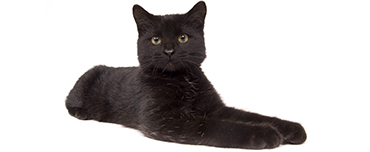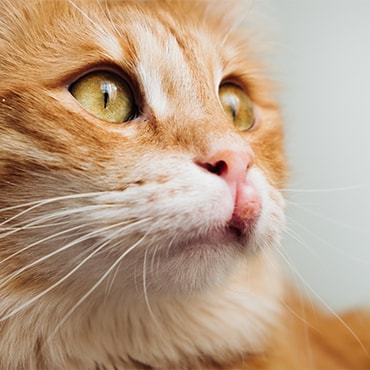Eosinophilic granuolma in cats

Overview
- Feline eosinophilic granuloma complex is a type of skin allergy that causes severe skin problems in cats.
- It’s a condition that’s usually triggered by something encountered in daily life, such as fleas, dust mites, food or pollen.
- There are three main types of eosinophilic skin disease, ‘granulomas’, ‘indolent or rodent ulcers’ and ‘plaques’ - each type causes slightly different symptoms.
- Symptoms of eosinophilic dermatitis can be quite severe and develop almost anywhere on the body but fortunately, they are usually manageable with treatment from a vet.
- Always contact your vet if you notice something wrong with your cat’s skin.
General information and causes
Eosinophilic dermatitis is a severe type of skin allergy that causes eosinophils (a type of blood cell) to gather at the surface of the skin and cause problems. It’s a condition that’s usually triggered by a reaction to something encountered in daily life, such as fleas, pollen or certain foods. Eosinophilic dermatitis can cause a variety of symptoms such as red/raised patches skin, lip ulcers and sometimes even a swollen chin! Fortunately, symptoms are usually manageable with treatment from a vet.
Symptoms
There are three main types of eosinophilic dermatitis that all cause slightly different symptoms:
Rodent ulcers
Eosinophilic ulcers (also commonly known as ‘indolent ulcers’ or ‘rodent ulcers’), are raised, eroded patches of skin that tend to affect the upper lip and roof of the mouth.
Eosinophilic plaques
Eosinophilic plaques are patches of round, red, angry, thickened skin that tend to be hairless, very itchy and painful. Plaques can develop anywhere, but are most common on the inner thighs, tummy, face and neck.
Eosinophilic granulomas
Eosinophilic granulomas are long thin patches of mildly itchy, swollen, weepy skin. They are most common on the back of the thigh, but can also develop on the chin, paws and inside the mouth.
Despite causing slightly different symptoms, all three types of eosinophilic lesion are treated in a very similar way.

This cat has an eosinophilic lesion on his lip
When to contact your vet
Always contact your vet if you think your cat has symptoms of eosinophilic skin disease. Left untreated, it’s a problem that tends to get a lot worse and is likely to make your cat miserable.
When you welcome a new cat into your life, consider taking out Cat Insurance straight away before any signs of illness start. This will give you peace of mind that you have some financial support if they ever get sick.
Treatment
Avoiding triggers
If you can find out what your cat is allergic to you may be able to prevent flare-ups of eosinophilic skin disease by avoiding the triggers. However, this may be difficult if your cat is allergic to more than one thing, or something that’s unavoidable such as pollen, mould or dust mites.
Anti-inflammatories
Most cats with eosinophilic dermatitis need anti-inflammatories, such as steroids, to control their inflamed, itchy skin. These can be given as a tablet, cream or injection. Many cats require life-long treatment and repeat courses of medication to keep their symptoms under control especially if it’s not possible to avoid the triggers for their allergies.
Flea treatment
Strict flea control is essential in cats with eosinophilic skin disease because their symptoms can get much worse if they are bitten by fleas.
Antibiotics
Antibiotics may be required if your cat has a skin infection.
Other medicines
Such as anti-histamines can be used alongside other drugs to reduce symptoms.
Surgery
Most cats improve with medical treatment but in severe cases, where skin just won’t heal, surgery may be necessary to speed up recovery.
Home care and home remedies
Protecting the skin
Your vet may advise a buster collar, a medical pet shirt or a dressing to protect your cat’s skin while it heals.
Food
If your cat’s eosinophilic dermatitis affects their mouth, they may need soft food to help them eat. If something in your cats food is a trigger, your vet may recommend a special diet to help keep their symptoms under control.
Skin supplements, shampoos and creams
Your vet might recommend a skin supplement, shampoo or cream to help keep your cat's skin healthy. You can find out more on our skin conditions overview page.
Natural remedies
There a number of different natural remedies which are marketed to help with skin problems for cats. Unfortunately, in many cases there is no evidence that they work. Speak to your vet before using any natural remedies for your cat - using the wrong product could make your cat’s skin a lot worse.
Outlook
Most cats with eosinophilic dermatitis respond very well to treatment. In many cases, symptoms of eosinophilic dermatitis come and go throughout life, but can usually be well managed with ongoing medication. If your cat doesn’t improve with treatment, they may need to visit a specialist veterinary clinic for further investigations.
Published: August 2020
Did you find this page useful?
Tell us more
Please note, our vets and nurses are unable to respond to questions via this form. If you are concerned about your pet’s health, please contact your vet directly.
Thank you for your feedback
Want to hear more about PDSA and get pet care tips from our vet experts?
Sign up to our e-newsletter
Written by vets and vet nurses. This advice is for UK pets only. Illustrations by Samantha Elmhurst.

